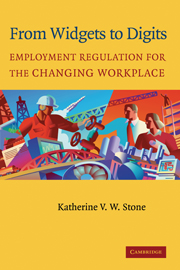Book contents
- Frontmatter
- Contents
- Preface
- Introduction
- PART I LABOR RELATIONS REGIMES OF THE PAST
- PART II THE DIGITAL WORKPLACE
- PART III IMPLICATIONS OF DIGITAL JOB STRUCTURES FOR LABOR AND EMPLOYMENT LAW
- PART IV SOCIAL JUSTICE IN THE DIGITAL ERA
- 11 The Crisis in Benefits and the Collapse of the Private Welfare State
- 12 The Working Rich and the Working Poor: Income Inequality in the Digital Era
- Summary and Conclusion
- Index
12 - The Working Rich and the Working Poor: Income Inequality in the Digital Era
Published online by Cambridge University Press: 14 January 2010
- Frontmatter
- Contents
- Preface
- Introduction
- PART I LABOR RELATIONS REGIMES OF THE PAST
- PART II THE DIGITAL WORKPLACE
- PART III IMPLICATIONS OF DIGITAL JOB STRUCTURES FOR LABOR AND EMPLOYMENT LAW
- PART IV SOCIAL JUSTICE IN THE DIGITAL ERA
- 11 The Crisis in Benefits and the Collapse of the Private Welfare State
- 12 The Working Rich and the Working Poor: Income Inequality in the Digital Era
- Summary and Conclusion
- Index
Summary
The changes in the employment relationship described in Part II have been accompanied by a marked deterioration in the income distribution. The U.S. income distribution has become considerably more unequal since 1970, a trend that accelerated in the 1980s and 1990s. Despite the economic boom of the 1990s, the working poor now comprise the fastest growing portion of the workforce. The burgeoning inequality threatens the integrity and moral authority of the social order. Those locked out of the world of economic opportunity are locked into a perpetual underclass, and often exhibit antisocial behaviors such as drug use, alcoholism, and crime. The extent of income inequality offends our sense of decency and undermines the possibility of social cohesion. It stands as a quiet but persistent reminder that current economic arrangements are not moving in the direction of economic justice.
The widening of the income distribution has occurred in the same period in which firms have dismantled their internal labor markets and begun to implement boundaryless human resource practices. The correspondence suggests that there may be a relationship between the two developments. This chapter explores the deterioration of the income distribution and its possible relationship to the changing job structures. It argues that one important factor that is driving the trend toward increased income inequality is the changing nature of the employment relationship. It further argues that in evaluating programs designed to promote income equality, we should choose those that help cushion the shocks and ease the transitions of workers as they experience the vicissitudes of the boundaryless workplace.
Information
- Type
- Chapter
- Information
- From Widgets to DigitsEmployment Regulation for the Changing Workplace, pp. 258 - 288Publisher: Cambridge University PressPrint publication year: 2004
